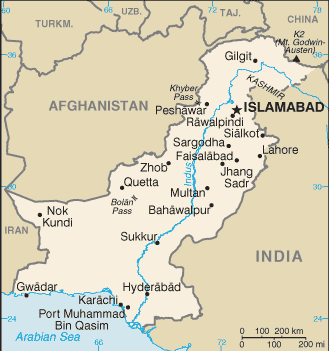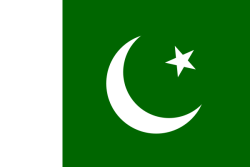Islamic Republic of Pakistan
Related Categories:
 Earliest writing found in Pakistan
Earliest writing found in PakistanThe first known examples of writing may have been unearthed at an archaeological dig in Pakistan.
news.bbc.co.uk/1/
President of the Islamic Republic of Pakistan.
www.presidentof
The white and dark green field represents minorities & Muslim majority, respectively.
www.fotw.us/
Modern day Pakistan consists of four major parts called provinces Sindh, Punjab, Balochistan and North-West Frontier Province. It also governs part of Kashmir which is currently split between Pakistan and India.
en.wikipedia.org/
People
The majority of Pakistan's population lives in the Indus River valley and in an arc formed by the cities of Faisalabad, Lahore, Rawalpindi/Islamabad, and Peshawar. Although Urdu is an official language of Pakistan, it is spoken as a first language by only 8% of the population; 48% speak Punjabi, 12% Sindhi, 10% Saraiki, 8% Pushtu, 3% Baloch, and 3% other. Urdu, Punjabi, Pushtu, and Baloch are Indo-European languages. English is the other official language, and is widely used in government, the officer ranks of the military, and in many institutions of higher learning.
Historical Overview
Pakistan, along with parts of western India, contains the archeological remains of an urban civilization dating back 4,500 years. Alexander the Great included the Indus Valley in his empire in 326 B.C., and his successors founded the Indo-Greek kingdom of Bactria based in what is today Afghanistan and extending to Peshawar. Following the rise of the Central Asian Kushan Empire in later centuries, the Buddhist culture of Afghanistan and Pakistan, centered on the city of Taxila just west of Islamabad, experienced a cultural renaissance known as the Gandhara period. Pakistan's Islamic history began with the arrival of Muslim traders in the 8th century in Sindh. The collapse of the Mughal Empire in the 18th century provided an opportunity for the English East India Company to extend its control over much of the subcontinent. The Sikh adventurer, Ranjit Singh, carved out a dominion that extended from Kabul to Srinagar and Lahore, encompassing much of the northern area of modern Pakistan. British rule replaced the Sikhs in the first half of the 19th century. In a decision that had far-reaching consequences, the British permitted the Hindu Maharaja of Kashmir, a Sikh appointee, to continue in power.
Pakistan emerged from an extended period of agitation by Muslims in the subcontinent to express their national identity free from British colonial domination as well as domination by what they perceived as a Hindu-controlled Indian National Congress. Muslim anti-colonial leaders formed the All-India Muslim League in 1906. Initially, the League adopted the same objective as the Congress--self-government for India within the British Empire--but Congress and the League were unable to agree on a formula that would ensure the protection of Muslim religious, economic, and political rights.
Pervez Musharraf
Following the October 12 ouster of the government of Prime Minister Sharif, the military-led government stated its intention to restructure the political and electoral systems. On October 14, 1999, General Musharraf declared a state of emergency and issued the Provisional Constitutional Order (PCO), which suspended the federal and provincial Parliaments, held the Constitution in abeyance, and designated Musharraf as Chief Executive. Musharraf appointed an eight-member National Security Council to function as Pakistan's supreme governing body, with mixed military/civilian appointees; a civilian Cabinet; and a National Reconstruction Bureau to formulate structural reforms. On May 12, 2000, Pakistan's Supreme Court unanimously validated the October 1999 coup and granted Musharraf executive and legislative authority for 3 years from the coup date. On June 20, 2001, Musharraf named himself as president and was sworn in.
After the World Trade Center and the Pentagon were attacked on September 11, 2001, Musharraf pledged complete cooperation with the United States in its war on terror, which included locating and shutting down terrorist training camps within its borders, cracking down on extremist groups and withdrawing support for the Taliban regime in Afghanistan. In a referendum held on April 30, 2002, Musharraf's presidency was extended by five more years. The handover from military to civilian rule came with parliamentary elections in November 2002, and the appointment of a civilian prime minister, Mir Zafarullah Khan Jamali. Having previously promised to give up his army post and become a civilian president, General Musharraf announced in late 2004 that he would retain his military role. In August 2004, Shaukat Aziz was sworn in as prime minister, having won a parliamentary vote of confidence, 191 of 342 votes, in which the opposition abstained.
On October 8, 2005 a magnitude 7.6 earthquake struck Pakistan, India, and Afghanistan. The epicenter of the earthquake was near Muzaffarabad, the capital of Pakistani-administered Kashmir, and approximately 60 miles north-northeast of Islamabad. An estimated 75,000 people were killed and 2.5 million people were left homeless. The disaster of such a huge magnitude galvanized an international rescue and reconstruction effort in support of the affected region. The earthquake cost Pakistan $1.1 billion on resettling those affected.
www.state.gov/r/
Introduction
About
Contact
Symbols in The News
Interpret this Symbol
AAC
African
AI
Alchemy
Alphabets
Ancient
Animal Symbolism
Architecture
Art
Articles
Astrology
Baha'i
Blissymbolics
Blueprint Symbols
Buddhist
Celtic Symbols
Cemetery
Chinese Symbols
Christian
Circle
City
Codes
Color
Conlangs
Crop Circles
Danger
Da Vinci Code
Designing Logos
Dictionaries
Dreams
Education
Egyptian Symbols
Electrical
Emoticons
Find Images
Fonts
Food
Fraternity
Hamsa
Healing
Heraldry
Hermetic
Highway Signs
Hindu
History
Hobo
Holiday
Icons
iConji
Islamic
Jain Symbols
Japanese, Kanji
Jewish
Justice
Law
Literary Symbolism
Mandalas
Map
Masonic
Math, Number
Meaning of Names
Medical
Middle East
Military
Miscellaneous
Money
Music
Mythology
Native American
Playing Cards
Power
Psychology
QiQiiKhu
Reiki
Religious
Runes, Norse
Sacred Geometry
Scientific
Science Fiction
Sorority
Sports
Symbols in the News
Tattoos
ThirteenSymbols
Tree of Life
Ursprache
Videos
Visual Languages
Weather
Web Codes
Wicca
Words
Writing Systems
Braille
Coinherence
Coptic
Cuneiform
Easter Island
Etruscan
Happy Human
Hebrew
Kokopelli
Linear B
Lotus
Love Symbols
Mandorla
Moon Alphabet
Nine Pointed Star
Om
Oz
Phonetic
Scarab Beetle
Silent
Theosophy
Unifon
About
Contact
Symbols in The News
Interpret this Symbol
AAC
African
AI
Alchemy
Alphabets
Ancient
Animal Symbolism
Architecture
Art
Articles
Astrology
Baha'i
Blissymbolics
Blueprint Symbols
Buddhist
Celtic Symbols
Cemetery
Chinese Symbols
Christian
Circle
City
Codes
Color
Conlangs
Crop Circles
Danger
Da Vinci Code
Designing Logos
Dictionaries
Dreams
Education
Egyptian Symbols
Electrical
Emoticons
Find Images
Fonts
Food
Fraternity
Hamsa
Healing
Heraldry
Hermetic
Highway Signs
Hindu
History
Hobo
Holiday
Icons
iConji
Islamic
Jain Symbols
Japanese, Kanji
Jewish
Justice
Law
Literary Symbolism
Mandalas
Map
Masonic
Math, Number
Meaning of Names
Medical
Middle East
Military
Miscellaneous
Money
Music
Mythology
Native American
Playing Cards
Power
Psychology
QiQiiKhu
Reiki
Religious
Runes, Norse
Sacred Geometry
Scientific
Science Fiction
Sorority
Sports
Symbols in the News
Tattoos
ThirteenSymbols
Tree of Life
Ursprache
Videos
Visual Languages
Weather
Web Codes
Wicca
Words
Writing Systems
Braille
Coinherence
Coptic
Cuneiform
Easter Island
Etruscan
Happy Human
Hebrew
Kokopelli
Linear B
Lotus
Love Symbols
Mandorla
Moon Alphabet
Nine Pointed Star
Om
Oz
Phonetic
Scarab Beetle
Silent
Theosophy
Unifon

